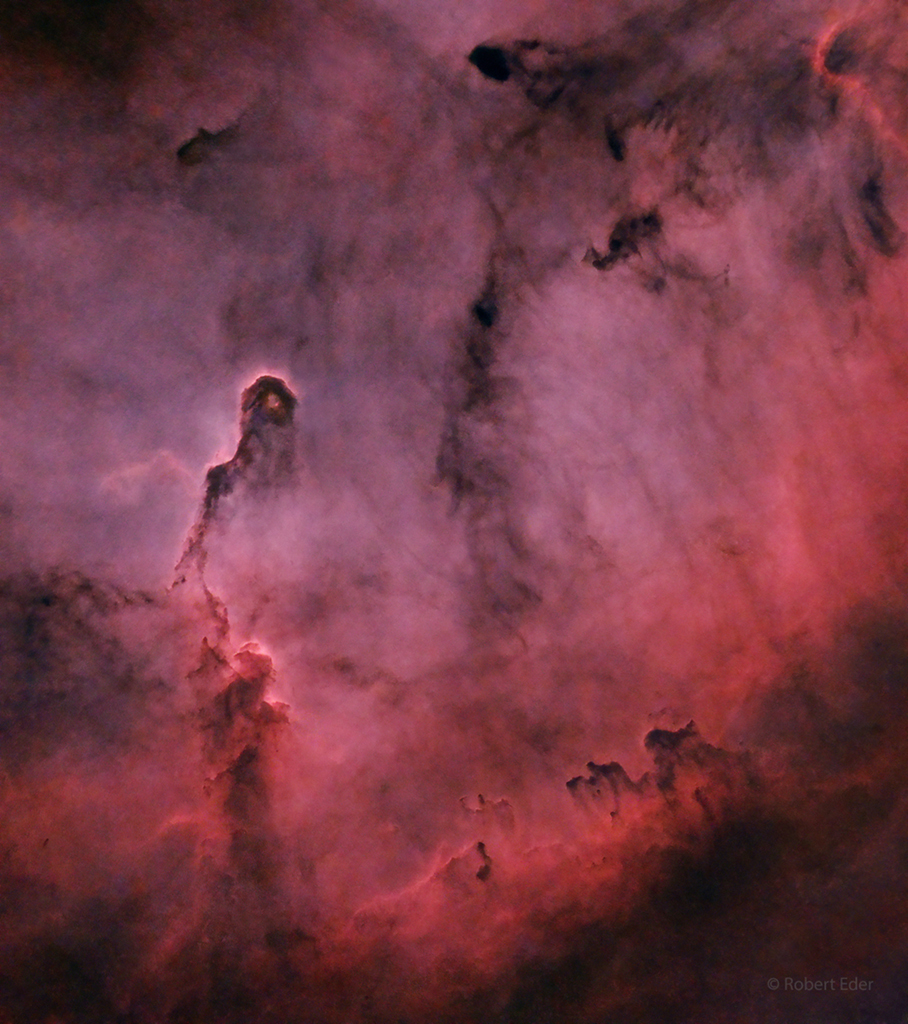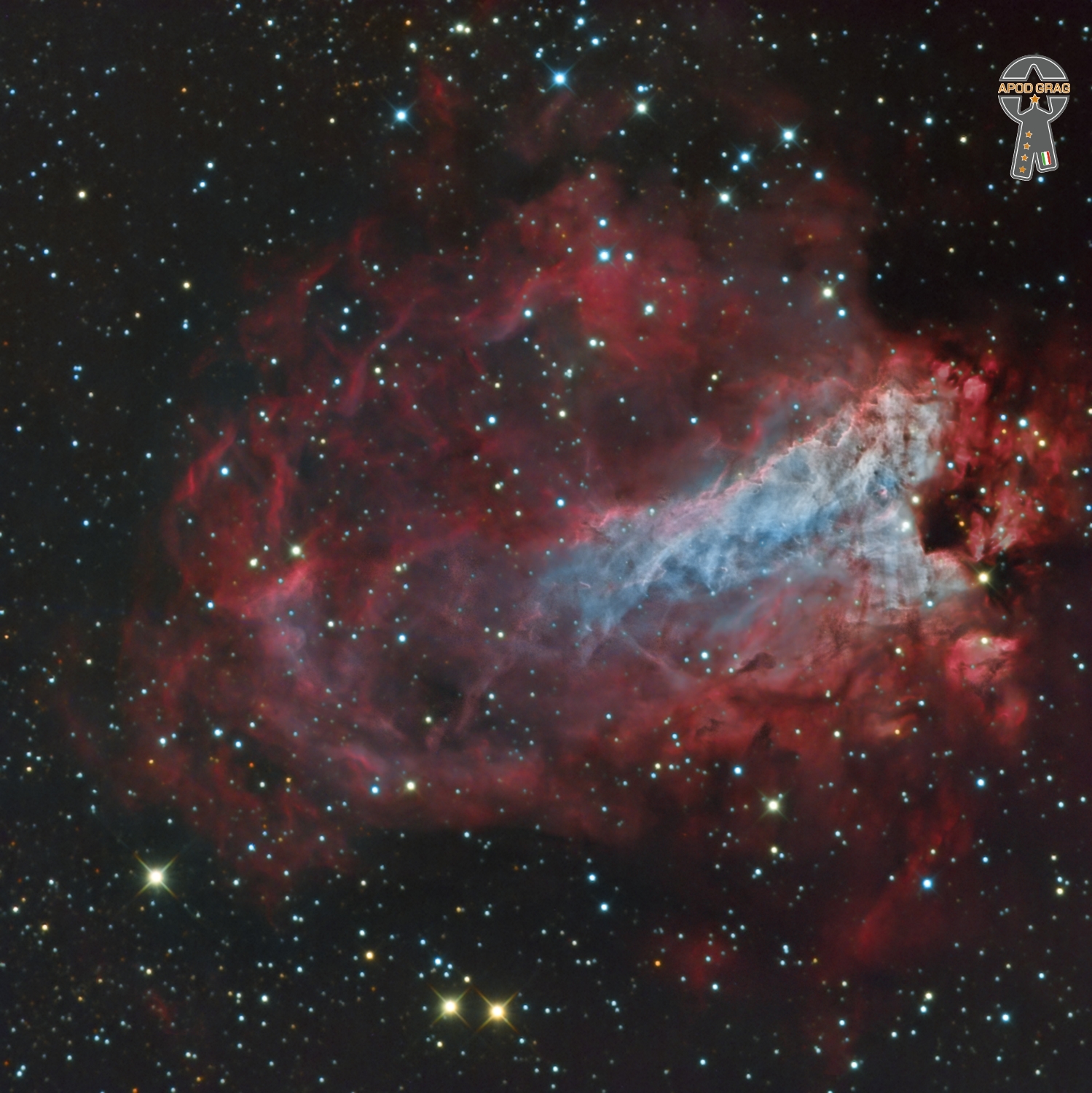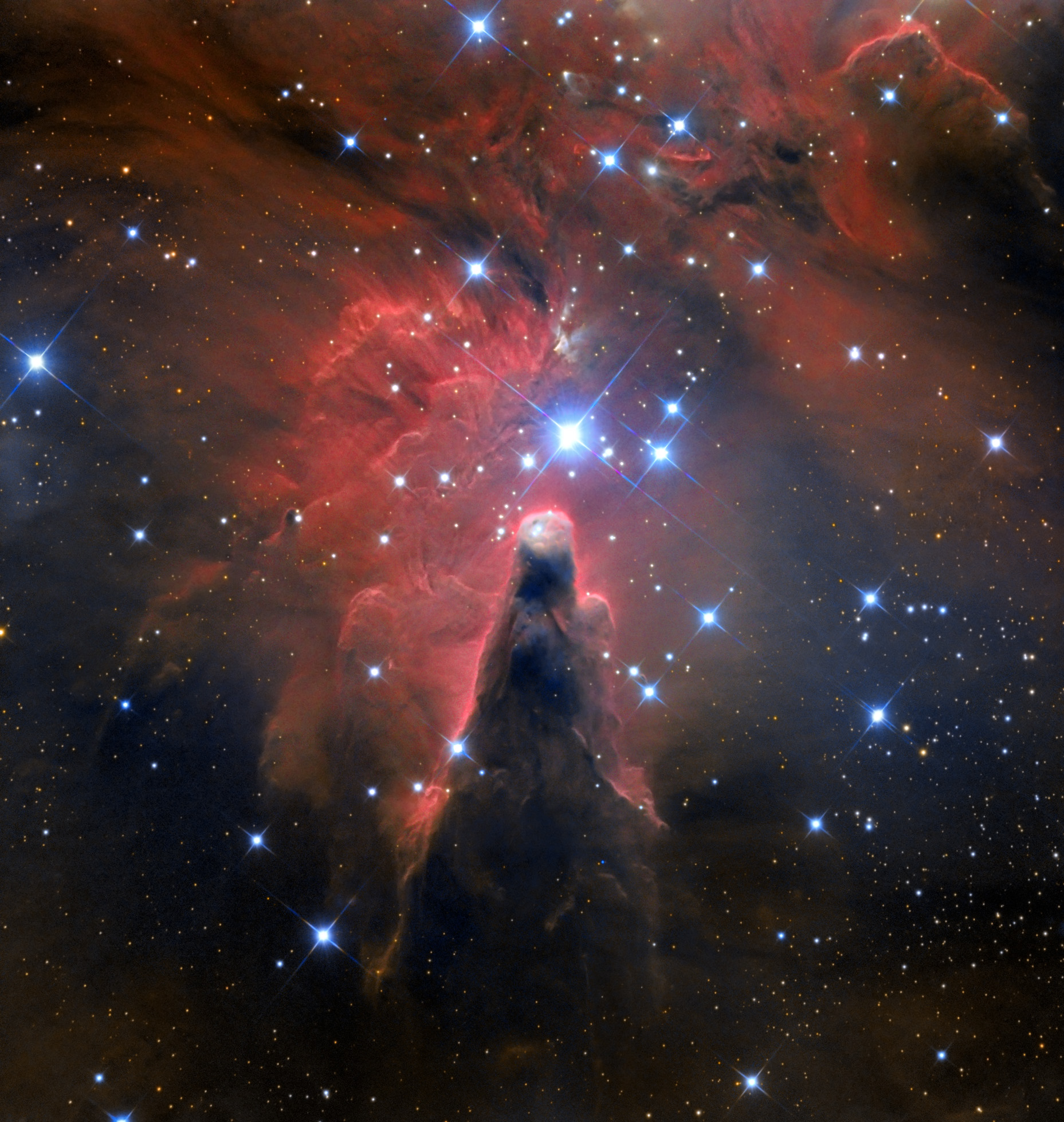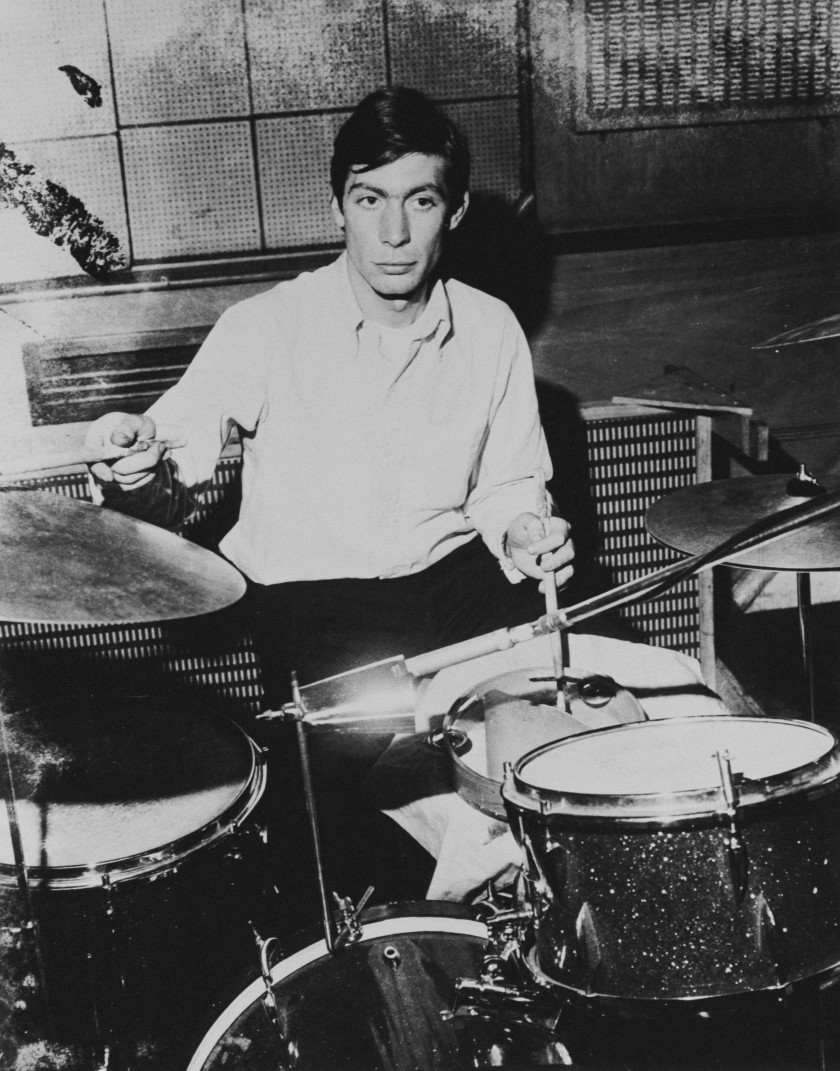Blog
the Elephant’s Trunk Nebula winds through the emission nebula and young star cluster complex IC 1396, in the high and far off constellation of Cepheus. Also known as vdB 142, seen on the left the cosmic elephant’s trunk is over 20 light-years long. Removed by digital processing, no visible stars are in this detailed telescopic close-up view highlighting the bright swept-back ridges that outline pockets of cool interstellar dust and gas. But the dark, tendril-shaped clouds contain the raw material for star formation and hide protostars within. Nearly 3,000 light-years distant, the relatively faint IC 1396 complex covers a large region on the sky, spanning over 5 degrees. This starless rendition spans a 1 degree wide field of view though, about the angular size of 2 full moons. Of course the dark shapes below and right, marching toward the winding Elephant’s Trunk, are known to some as The Caravan.

Alice Coltrane (née McLeod; August 27, 1937 – January 12, 2007), also known by her adopted Sanskrit name Turiyasangitananda, was an American jazz musician and composer, and in her later years a swamini. An accomplished pianist and one of the few harpists in the history of jazz, she recorded many albums as a bandleader, beginning in the late 1960s and early 1970s for Impulse! and other major record labels.She was married to jazz saxophonist and composer John Coltrane, with whom she performed in 1966–1967. She founded the Vedantic Center in 1975 and the Shanti Anantam Ashram in California in 1983, where she served as spiritual director. On July 3, 1994, Swamini rededicated and inaugurated the land as Sai Anantam Ashram.
Coltrane was born Alice McLeod on August 27, 1937, in Detroit, Michigan, and grew up in a musical household. Her mother, Anna McLeod, was a member of the choir at her church, and her half brother, Ernest Farrow, became a jazz bassist. With the encouragement of her father, Alice McLeod pursued music and started to perform in various clubs around Detroit, until moving to Paris in the late 1950s. She studied classical music, and also jazz with Bud Powell in Paris, where she worked as the intermission pianist at the Blue Note Jazz Club in 1960. It was there that McLeod appeared on French television in a performance with Lucky Thompson, Pierre Michelot and Kenny Clarke.[4] She married Kenny “Pancho” Hagood in 1960 and had a daughter with him. The marriage ended soon after, on account of Hagood’s developing heroin addiction, and McLeod was forced to move back to Detroit with her daughter. She continued playing jazz as a professional in Detroit, with her own trio and as a duo with vibraphonist Terry Pollard. In 1962–63 she played with Terry Gibbs‘ quartet, during which time she met John Coltrane. In 1965 they were married in Juárez, Mexico. John Coltrane became stepfather to Alice Coltrane’s daughter Michelle, and the couple had three children together: John Jr. (1964, a bassist who died in a car accident in 1982); Ravi (b. 1965, a saxophonist); and Oranyan (b. 1967, a DJ). Oranyan later played saxophone with Santana for a period of time.
https://www.youtube.com/watch?v=8H6sRYIaChw
more...Lester Willis Young (August 27, 1909 – March 15, 1959), nicknamed “Pres” or “Prez”, was an American jazz tenor saxophonist and occasional clarinetist. Coming to prominence while a member of Count Basie‘s orchestra, Young was one of the most influential players on his instrument. In contrast to many of his hard-driving peers, Young played with a relaxed, cool tone and used sophisticated harmonies, using what one critic called “a free-flo
Lester Young was born in Woodville, Mississippi, on August 27, 1909. His mother was Lizetta Young (née Johnson), and his father was Willis Handy Young, originally from Louisiana. Lester had two siblings – Leonidas Raymond, who became a drummer, and Irma Cornelia. He grew up in a musical family. His father was a teacher and band leader, and several other relatives performed professionally. Young made his final studio recordings and live performances in Paris in March 1959 with drummer Kenny Clarke at the tail end of an abbreviated European tour during which he ate next to nothing and drank heavily. On a flight to New York City, he suffered from internal bleeding due to the effects of alcoholism and died in the early morning hours of March 15, 1959, only hours after arriving back in New York, at the age of 49.
more...
Tientos, a slow cante jondo music and dance in a four-count rhythm, was first developed by the singer Enrique el Mellizo (1848 -1906) as an expressive variation of the Tangos.Poet Federico García Lorca considered the Tientos to be almost liturgical in its solemnity. Traditional Tientos lyrics – letras – set a dark mood, and have to do with loss, unrequited love, imprisionment, longing for freedom and other serious messages. Dancers strive to capture this mood in their solos. The most notable aspect of the slow Tientos tempo is the beat structure. Where the first beat in Tangos is subdued, it is strongly emphasized in the Tientos, as is the “and” of the second beat.
more...The Omega Nebula, also known as the Swan Nebula, Checkmark Nebula, Lobster Nebula, and the Horseshoe Nebula (catalogued as Messier 17 or M17 or NGC 6618) is an H II region in the constellation Sagittarius. It was discovered by Philippe Loys de Chéseaux in 1745. Charles Messier catalogued it in 1764. It is by some of the richest starfields of the Milky Way, figuring in the northern two-thirds of Sagittarius.
The Omega Nebula is between 5,000 and 6,000 light-years from Earth and it spans some 15 light-years in diameter. The cloud of interstellar matter of which this nebula is a part is roughly 40 light-years in diameter and has a mass of 30,000 solar masses. The total mass of the Omega Nebula is an estimated 800 solar masses.

Branford Marsalis (born August 26, 1960) is an American saxophonist, composer, and bandleader. While primarily known for his work in jazz as the leader of the Branford Marsalis Quartet, he also performs frequently as a soloist with classical ensembles and has led the group Buckshot LeFonque. From 1992 to 1995 he led the Tonight Show Band.
Marsalis was born on August 26, 1960, in Breaux Bridge, Louisiana, and raised in New Orleans. He is the son of Dolores (née Ferdinand), a jazz singer and substitute teacher, and Ellis Louis Marsalis, Jr., a pianist and music professor. His brothers Jason Marsalis, Wynton Marsalis, and Delfeayo Marsalis are also jazz musicians.
more...Leon Redbone (born Dickran Gobalian, August 26, 1949 – May 30, 2019) was an American singer-songwriter and musician specializing in jazz, blues, and Tin Pan Alley classics. Recognized by his hat (often a Panama hat), dark sunglasses, and black tie, Redbone was born in Cyprus of Armenian ancestry and first appeared on stage in Toronto, Canada, in the early 1970s. He also appeared on film and television in acting and voice-over roles.
In concert Redbone often employed comedy and demonstrated his skill in guitar playing. Recurrent gags involved the influence of alcohol and claiming to have written works originating well before he was born – Redbone favored material from the Tin Pan Alley era, circa 1890 to 1910. He sang the theme to the 1980s television series Mr. Belvedere and released eighteen albums.
Redbone was elusive about his origins, and never explained the origin of his stage name. According to a Toronto Star report in the 1980s, he was once known as Dickran Gobalian, and he came to Canada from Cyprus in the mid-1960s and changed his name via the Ontario Change of Name Act. Biographical research published in 2019 corroborated his birth name, and stated that his family was of Armenian origin.[2] His parents lived in Jerusalem, but fled in 1948 to Nicosia, Cyprus, where Redbone was born. By 1961, the family had moved to London, England, and by 1965 to Toronto.
more...more...Charles Robert “Charlie” Watts, the Rolling Stones’ drummer and the band’s irreplaceable heartbeat, has died at age 80. No cause of death was given.
Watts’ publicist confirmed his death in a statement. “It is with immense sadness that we announce the death of our beloved Charlie Watts,” it read. “He passed away peacefully in a London hospital earlier [Tuesday] surrounded by his family.” The statement referred to Watts as “one of the greatest drummers of his generation” and closed by requesting that “the privacy of his family, band members, and close friends is respected at this difficult time.”
Watts’ death comes several weeks after it was announced that the drummer would not be able to perform on the Rolling Stones’ No Filter Tour of U.S. stadiums. “Charlie has had a procedure which was completely successful, but his doctors this week concluded that he now needs proper rest and recuperation,” a rep for the band said in a statement at the time. “With rehearsals starting in a couple of weeks, it’s very disappointing to say the least, but it’s also fair to say no one saw this coming.”
The 5th in a series of Rhythm Roots Workshops at the MN VA Home Adult Center working with the Memory Loss Unit. My soldiers are digging in deep to cultural rhythms and feeling the Healing Power of drumming. Wednesday August 25 10-noon.

NGC 2264 is the designation number of the New General Catalogue that identifies two astronomical objects as a single object: the Cone Nebula, and the Christmas Tree Cluster. Two other objects are within this designation but not officially included, the Snowflake Cluster, and the Fox Fur Nebula.
All of the objects are located in the Monoceros constellation and are located about 800 parsecs or 2,600 light-years from Earth.
NGC 2264 is sometimes referred to as the Christmas Tree Cluster and the Cone Nebula. However, the designation of NGC 2264 in the New General Catalogue refers to both objects and not the cluster alone.
NGC 2264 is the location where the Cone Nebula, the Stellar Snowflake Cluster and the Christmas Tree Cluster have formed in this emission nebula. For reference, the Stellar Snowflake Cluster is located 2,700 light years away in the constellation Monoceros. The Monoceros constellation is not typically visible by the naked eye due to its lack of colossal stars.

Linda May Han Oh (born 25 August 1984) is an Australian jazz bassist and composer.
Oh was raised in Western Australia. When she was 11, she started to play the clarinet and at the age of 13 bassoon. As a bass guitarist she started in a high school band; and in 2002 she attended the Western Australian Academy of Performing Arts, where she picked up the upright bass and studied solo transcriptions of Dave Holland. Her thesis was on the classical Indian music rhythms in Holland’s solos. After more scholarships she moved to New York in 2008, where she completed her master’s degree at the Manhattan School of Music, among others with Jay Anderson, John Riley, Phil Markowitz, Dave Liebman and Rodney Jones as supervisors.
more...Pat Martino (born Patrick Azzara; August 25, 1944) is an American jazz guitarist and composer.
Martino was born Patrick Azzara in South Philadelphia. He began playing professionally at the age of 15 after moving to New York City. He lived for a period with Les Paul and began playing at jazz clubs such as Smalls Paradise. He later moved into a suite in the President Hotel on 48th Street. He would play at Smalls for six months of the year, and then in the summer play at the Club Harlem in Atlantic City.
Martino played and recorded early in his career with Lloyd Price, Willis Jackson, and Eric Kloss. He also worked with jazz organists Charles Earland, Richard “Groove” Holmes, Jack McDuff, Don Patterson, Trudy Pitts, Jimmy Smith, Gene Ludwig, and Joey DeFrancesco.
more...Wayne Shorter (born August 25, 1933) is an American jazz saxophonist and composer. Shorter came to wide prominence in the late 1950s as a member of, and eventually primary composer for, Art Blakey‘s Jazz Messengers. In the 1960s, he went on to join Miles Davis‘s Second Great Quintet, and from there he co-founded the jazz fusion band Weather Report. He has recorded over 20 albums as a bandleader.
Many of Shorter’s compositions have become jazz standards, and his output has earned worldwide recognition, critical praise and various commendations. Shorter won 11 Grammy Awards. He has also received acclaim for his mastery of the soprano saxophone (after switching his focus from the tenor in the late 1960s), beginning an extended reign in 1970 as Down Beat‘s annual poll-winner on that instrument, winning the critics’ poll for 10 consecutive years and the readers’ for 18. The New York Times described Shorter in 2008 as “probably jazz’s greatest living small-group composer and a contender for greatest living improviser”. In 2017, he was awarded the Polar Music Prize.
Wayne Shorter was born in Newark, New Jersey, and attended Newark Arts High School, from which he graduated in 1952. He loved music, being encouraged by his father to take up the clarinet as a teenager; his older brother Alan played alto saxophone before switching to the trumpet in college. While in high school Wayne also performed with the Nat Phipps Band in Newark. After graduating from New York University with a degree in music education in 1956, Shorter spent two years in the U.S. Army, during which time he played briefly with Horace Silver. After his discharge, he played with Maynard Ferguson. In his youth Shorter had acquired the nickname “Mr. Gone”, which later became an album title for Weather Report.
more...Leonard Bernstein (/ˈbɜːrnstaɪn/ BURN-styne; August 25, 1918 – October 14, 1990 Lawrence, MA) was an American conductor, composer, pianist, music educator, author, and humanitarian. Among the most important conductors of his time, he was also the first American conductor to receive international acclaim. According to music critic Donal Henahan, he was “one of the most prodigiously talented and successful musicians in American history”.
As a composer he wrote in many styles, including symphonic and orchestral music, ballet, film and theatre music, choral works, opera, chamber music and works for the piano. His best-known work is the Broadway musical West Side Story, which continues to be regularly performed worldwide, and was made into an Academy Award–winning feature film. His works include three symphonies, Chichester Psalms, Serenade after Plato’s “Symposium”, the original score for the film On the Waterfront, and theater works including On the Town, Wonderful Town, Candide, and his MASS.
Bernstein was the first American-born conductor to lead a major American symphony orchestra. He was music director of the New York Philharmonic and conducted the world’s major orchestras, generating a significant legacy of audio and video recordings. He was also a critical figure in the modern revival of the music of Gustav Mahler, the composer whose music he was most passionately interested in. A skilled pianist, he often conducted piano concertos from the keyboard.
Bernstein was the first conductor to share and explore music on television with a mass audience. Through dozens of national and international broadcasts, including the Emmy Award–winning Young People’s Concerts with the New York Philharmonic, he made even the most rigorous elements of classical music an adventure in which everyone could join. Through his educational efforts, including several books and the creation of two major international music festivals, he influenced several generations of young musicians.
A lifelong humanitarian, Bernstein worked in support of civil rights; protested against the Vietnam War; advocated for nuclear disarmament; raised money for HIV/AIDS research and awareness; and engaged in multiple international initiatives for human rights and world peace. Near the end of his life, he conducted a historic performance of Beethoven’s Symphony No. 9 in Berlin to celebrate the fall of the Berlin Wall. The concert was televised live, worldwide, on Christmas Day, 1989.
Bernstein was the recipient of many honors, including eleven Emmy Awards, one Tony Award, seventeen Grammy Awards, including the Lifetime Achievement and the Kennedy Center Honor.
more...More Posts
- Carlos Potato Valdés Day
- World Music with Seun Kuti
- Daily Roots with the Twinkle Brothers
- The Cosmos with IC 63
- Azar Lawrence Day
- Henry Grimes Day
- Billy Mitchell Day
- World Music with Paco de Lucia
- Daily Roots with Clarence Parks
- Muertos de Dias 2018
- All Souls Day 2018
- The Cosmos with W63
- Rubim de Toledo Day
- Phil Woods Day
- World Music with Åse Teigland
- Daily Roots with Earl Zero
- Happy All Saints Day 2018
- The Cosmos with HBC 672
- Lyle Lovett Day
- Lou Donaldson Day
